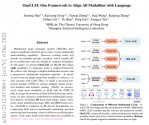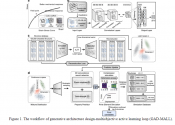Look at this Li Auto now has the best Chinese language model according to C-EVAL and CMMLU. It's truly impressive that auto companies and phone companies have the best LLMs in China. What is going on with big tech? Or, are the hard tech companies the best in all tech?
You are using an out of date browser. It may not display this or other websites correctly.
You should upgrade or use an alternative browser.
You should upgrade or use an alternative browser.
Artificial Intelligence thread
- Thread starter 9dashline
- Start date
Recent development on a machine learning-based metamaterial design method for the design of 3D printed porous bone implants
Associate Professor Dr. Peng Wen and his collaborative team at the Department of Mechanical Engineering, Tsinghua University, developed an innovative architected metamaterial design methodology using a generative architecture design and multiobjective active learning loop (GAD-MALL) combined algorithm. This novel approach has proven effective for the design and optimization of 3D-printed porous metal bone implants, presenting a versatile solution toward solving high-dimensional multi-objective problems with data sparsity and enormity of the search space in metamaterial design.
Architected materials are one of the most widely adopted engineering materials. Due to their excellent mechanical performance and adaptable properties, architected materials are very popular in many fields, such as those of lightweight structures, tissue engineering, battery electrodes, and electromagnetics. Moreover, recent progress in 3D printing has further enabled the customized and inexpensive fabrication of complex material geometries. Despite the broad applicability and immense potential of architected materials, designing them is particularly difficult. The traditional method generally relies on numerical simulation and theoretical analysis which are usually exhausting and time-consuming. Recently, machine learning (ML) has emerged as a promising technique to circumvent this problem and find the optimal solution without any prior knowledge requirements. Furthermore, active learning that combines ML and simulations or experiments to tackle optimization problems is an emerging topic at the frontier of science. However, some of these methods mainly focus on 2D-structure-related problems, while others use Bayesian optimization to solve low-dimensional problems or focus on an unconstrained single objective. The efforts toward solving high-dimensional multi-objective problems are often obfuscated by the data sparsity, the enormity of the search space, and stringent external constraints. For example, porous bone implants should align with the elastic modulus of bone tissue, while also providing adequate compressive strength and biocompatibility; meanwhile, a porous structure comprising 3*3*3 units, with each unit varying across seven porosity levels, can yield an immense 727 potential designs.
The research introduces an inventive integration of a generative model, three-dimensional convolutional neural network (3D-CNN), and numerical simulations within the GAD-MALL algorithm for designing architected metamaterial structures. The process begins with unsupervised learning on a dataset of over 18,000 porous geometries using an autoencoder model to distil high-dimensional data into a low-dimensional latent space representation. Gaussian mixture models are then employed for sampling in the latent space, with the decoder reconstructing the sampled data to new architected metamaterial designs. 3D-CNN models are then used to predict the performance of these new designs and select the designs with high predicted performance, which are subsequently validated through numerical simulations. Through iterative cycles of generation, prediction, and simulation, the GAD-MALL algorithm effectively optimizes the multi-objective performance of the structures. Optimal designs are 3D-printed and experimentally validated, demonstrating significant improvements over conventional designs and confirming the efficacy of this AI-driven design paradigm in addressing the challenges of high-dimensional multi-objective optimization in designing architected metamaterials.
Copium article from some US nat sec boy:
Brings up the following three points:
This somehow means that China will forever be 2-4 years behind the US in AGI development.
Brings up the following three points:
- Hugging face database is blocked in China
- Chinese internet slang sucks for AGI training (Asian language is too inscrutable for AI to understand)
- It takes too long to register a LLM in China (2-3 months)
This somehow means that China will forever be 2-4 years behind the US in AGI development.
China's generative AI market is expected to surpass CNY10 trillion (USD1.4 trillion) this year, according to a research institute under the MIIT. China may contribute 40% of the AI-driven global economy worth CNY90 trillion (USD12.6 trillion) by 2035, it added...
I will say that Kevin is on one of my discord's group and he is not a US natsec boy at all. He just doesn't have the same perspective on certain areas as we do.Copium article from some US nat sec boy:
Brings up the following three points:
- Hugging face database is blocked in China
- Chinese internet slang sucks for AGI training (Asian language is too inscrutable for AI to understand)
- It takes too long to register a LLM in China (2-3 months)
This somehow means that China will forever be 2-4 years behind the US in AGI development.
although imo, all of his points just make it harder for outside AI firms from beating Chinese firms in Chinese language LLM
Well, at least the Chinese LLM is secured within China.I will say that Kevin is on one of my discord's group and he is not a US natsec boy at all. He just doesn't have the same perspective on certain areas as we do.
although imo, all of his points just make it harder for outside AI firms from beating Chinese firms in Chinese language LLM
Yet, the outside (i.e. international) world still needs to be addressed. Can't let the US have all the sway and advantage, especially with China's ever growing importance on the world stage.
I think this is the first time I am reading language as a barrier to progress in A.I.I will say that Kevin is on one of my discord's group and he is not a US natsec boy at all. He just doesn't have the same perspective on certain areas as we do.
although imo, all of his points just make it harder for outside AI firms from beating Chinese firms in Chinese language LLM
English is a simple language to learn and for the big teams training A.I models in China, surely all of them must have the ability to work in English too.
For the smaller teams, language may be a problem, but they face much bigger issues such as affordable chips. Language is the least of their problems.
Doctoral teachers and students from Tsinghua University’s innovative leading engineering team visited Moore Thread to discuss the development of the large model industry
December 11, 2023
On December 9, all the teachers and students of Tsinghua University’s Class 5 of 2023 Innovation Leading Engineering Ph.D.s visited Moore Thread and carried out a visiting activity with the theme of “Research on the Artificial Intelligence Large Model Industrial Chain System in Beijing”. Moore Thread founder and CEO Zhang Jianzhong, COO Zhou Yuan and others participated in the sharing and exchange.
Tsinghua University’s Innovative Leadership Engineering PhD Program was launched in 2018, aiming to cultivate people with solid and broad basic theories and systematic and in-depth expertise, and the ability to solve complex engineering technology problems, carry out engineering technology innovation, and plan and organize the implementation of engineering technology research and development work. Capabilities, innovative leading talents in engineering categories who can make innovative achievements in their engineering categories.
The research team watched the application demonstration of Moore Thread's full-featured GPU in the fields of large models, AIGC, digital twins, physical simulation, 3D graphics rendering, etc., listened to the introduction of Moore Thread's company and products, and conducted in-depth discussions and exchanges with Moore Thread. Have a comprehensive understanding of threaded full-featured GPU chips and their layout in the large model industry chain.
As large models continue to develop towards multi-modality, it is increasingly difficult for a single type of computing power to meet the complex computing needs of different application scenarios. It has four major capabilities: modern graphics rendering, intelligent multimedia, AI computing acceleration, physical simulation and scientific computing. The engine's Moore threaded full-featured GPU has natural advantages and is the best computing power base for large model training and inference. Moore Thread will continue to provide efficient and diverse computing power for AIGC, ChatGPT-like, digital twins, physical simulation, metaverse and other fields to help high-quality development of the digital economy.
On December 9, all the teachers and students of Tsinghua University’s Class 5 of 2023 Innovation Leading Engineering Ph.D.s visited Moore Thread and carried out a visiting activity with the theme of “Research on the Artificial Intelligence Large Model Industrial Chain System in Beijing”. Moore Thread founder and CEO Zhang Jianzhong, COO Zhou Yuan and others participated in the sharing and exchange.
Tsinghua University’s Innovative Leadership Engineering PhD Program was launched in 2018, aiming to cultivate people with solid and broad basic theories and systematic and in-depth expertise, and the ability to solve complex engineering technology problems, carry out engineering technology innovation, and plan and organize the implementation of engineering technology research and development work. Capabilities, innovative leading talents in engineering categories who can make innovative achievements in their engineering categories.
The research team watched the application demonstration of Moore Thread's full-featured GPU in the fields of large models, AIGC, digital twins, physical simulation, 3D graphics rendering, etc., listened to the introduction of Moore Thread's company and products, and conducted in-depth discussions and exchanges with Moore Thread. Have a comprehensive understanding of threaded full-featured GPU chips and their layout in the large model industry chain.
As large models continue to develop towards multi-modality, it is increasingly difficult for a single type of computing power to meet the complex computing needs of different application scenarios. It has four major capabilities: modern graphics rendering, intelligent multimedia, AI computing acceleration, physical simulation and scientific computing. The engine's Moore threaded full-featured GPU has natural advantages and is the best computing power base for large model training and inference. Moore Thread will continue to provide efficient and diverse computing power for AIGC, ChatGPT-like, digital twins, physical simulation, metaverse and other fields to help high-quality development of the digital economy.


